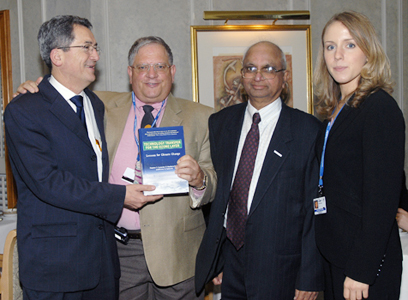|
Technology Transfer for the Ozone Layer Lessons for Climate Change
Technology transfer–the
development of practical applications and commercialization of research–for
positive environmental outcomes is the crux of many of the 230 international
environmental treaties, and is widely viewed as essential to the Kyoto Protocol
and success in the global fight against climate change. Internationally there is
considerable debate on the obstacles to transfer of, and change to,
environmentally sound technologies particularly for the developing countries yet
no comprehensive assessment of what works.
Executive Secretary Marco Gonzalez, Stephen Anderson, US EPA, K. Madhava Sarma, former Ozone Executive Secretary, and Kristin Taddonio, US EPA, during the book launch for "Techonology Transfer for the Ozone Layer: Lessons for Climate Change." Credit: Earth Negotiations Bulletin To date, one of the most
successful environmental treaties—and the source of the greatest achievement in
technology transfer for international environmental protection—is the Vienna
Convention on the Protection of the Ozone Layer (1985) and its Montreal Protocol
on Substances that Deplete the Ozone Layer (1987), brokered by the United
Nations Environment Programme. The experience regarding the ozone-friendly
technologies under the Montreal Protocol is now 15 years old and this landmark
book provides a comprehensive analysis of the vast experience of technology
transfer of the Montreal Protocol and draw out key lessons for the climate
change and other global environmental challenges. Stephen O. Andersen is a Director of Strategic Projects in the US Environmental Protection Agency (EPA) Climate Protection Partnerships Division and a Co-Chair of the Montreal Protocol Technology and Economic Assessment Panel. He was formerly Deputy Director of the EPA Stratospheric Protection Division where he specialized in industry partnerships, international cooperation and market incentives. K. Madhava Sarma is a consultant on ozone issues and was formerly Executive Secretary, Secretariat for the Vienna Convention and the Montreal Protocol, United Nations Environment Programme. Kristen Taddonio Taddonio is Manager of Strategic Climate Projects at the US Environmental Protection Agency. Contents List of Figures, Tables and
Boxes; About the Authors; Foreword—Monique Barbut; Preface—Achim Steiner;
Acknowledgements; Introduction—Marco Gonzales; 1) Prologue; 2) Contours of
Technology Transfer; 3) Background of the Ozone and Climate Agreements; 4)
Technology Change in Developed Countries; 5) Military and Space Agency
Leadership to Protect the Ozone Layer; 6) Technology Transfer to Phase Out ODSs
in Foams; 7) Technology Transfer To Phase Out ODSs in Refreigeration and
Air-Conditioning; 8) Technology Transfer to Phase Out ODSs in Aerosol Products;
9) Technology Transfer to Phase Out ODSs on Fire Protection; 10) Technology
Transfer to Phase Out ODSs on Solvents; 11) Technology Transfer to Phase Out
ODSs in Pest Control; 12) Barriers to Technology Transfer Faced by CEITs and
Developing Countries; 13) Awareness and Capacity-Building; 14) Lessons; Appendix
1: Control Measure of the Montreal Protocol; Appendix 2: Indicative List of
Categories of Incremental Costs; Appendix 3: List of Project Completion Reports
Studies; Appendix 4: A Technology Transfer Agreement; Appendix 5: List of
Military ODS Management and Phaseout Initiatives in the US; Appendix 6: Useful
Websites for Information on Military Phaseout; Appendix 7) Ozone and Climate
Protection Awards Won by Military Organizations; Notes; List of Acronyms and
Abbreviations; Glossary; About the Contributors; Index. “This authoritative and
meticulously researched treatise cuts to the heart of the problem: the crucial
issues of technology, research, development and diffusion that have been largely
lost in the hot air of climate rhetoric.” “The book is extremely valuable
reading for policy makers and scholars alike, particularly in the context of the
challenge of climate change being faced globally.” “This book gives an authoritative
account of how impossible challenges to transfer of ozone-friendly technologies
were overcome for the good of human society.” “Imagine what we can accomplish
as we continue to transfer technology to protect the climate.” "Imagine the pride of earning the
Nobel Prize for warning that CFCs were destroying the ozone layer. Then imagine
that citizens, policymakers, and business executives heeded the warning and
transformed markets to protect the earth. This book is the story of why we can
all be optimistic about the future if we are willing to be brave and dedicated
world citizens." |





